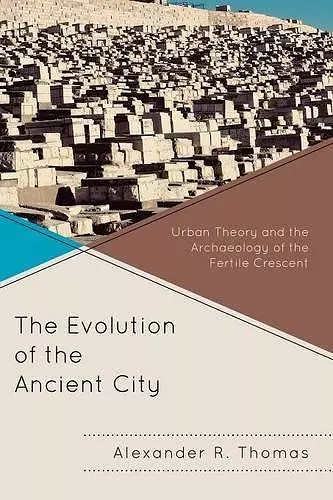The Evolution of the Ancient City
Urban Theory and the Archaeology of the Fertile Crescent
Format:Paperback
Publisher:Bloomsbury Publishing PLC
Published:7th Jun '12
Currently unavailable, and unfortunately no date known when it will be back
This paperback is available in another edition too:
- Hardback£98.00(9780739138694)

Urban theory and archaeology merge to create a readable discussion of how ancient cities came to be. Although many consider our modern social ills to be the consequence of Capitalism, many urban problems are traceable to pre-Capitalist times and thus are more related to Urbanization. Ancient cities shared many characteristics with modern cities. For instance, the ancient cities of Rome and Carthage at the time of Christ had population densities approaching that of Manhattan Island today. The Canaanites, fifteen hundred years before, lived in cities oriented toward trade and dependent upon mass production of such items as wine, olive oil, and the pottery to contain such goods. Over three thousand years before the Common Era, the city of Uruk was part of a larger "global system" that resembled in its own way the globalization that we know today. Cities first arose in Mesopotamia about 5,500 years ago, but for 5,500 years before the rise of cities the small agricultural village was the most complex form of human social organization—clearly there was nothing inevitable about the city. The Evolution of the Ancient City explores what we can learn of modern cities by tracing the development of ancient cities.
Fascinating to read! Thomas brings a sociological perspective to the topic of how cities began, combining insights from standard urban theory with more classical sociological theory as well as anthropology and archaeology. He is able to do this partly as a result of having studied in many departments that combined the disciplines of sociology and anthropology, thus demonstrating that what most would criticize as of little value can lead to new insights and new ways of thinking. Focusing on “pristine cities” (which could not have developed in response to other urban forms), Thomas points to similarities and differences between them and current cities. He then shows that many of the characteristics we associate with modern cities actually existed long before the first cities emerged, many of the structures we consider unique to contemporary cities are found in ancient ones as well, and that contemporary urban problems such as inequality and segregation have ancient roots. The power of this work is how it causes the reader to question and re-frame urban sociology, and move from a focus on the city as the unit of analysis to that of the “urban system” which includes all areas, including rural ones, and cities of all sizes, into a more comprehensive understanding of contemporary urban society. I highly recommend it to urban sociologists and all those interested in urban life in general. They will not be disappointed. -- Nancy Denton, University of Albany, SUNY
Thomas deploys contemporary urban theory to examine the origin of cities in the ancient world. He also demonstrates how much we have to learn from this early history—especially that the urban process is not just about cities but about the growing spatial scale of societies. Globalization takes on new meaning when we see it in the context of more than ten thousand years of change. -- John R. Logan, Brown University
Sociologist Thomas (SUNY Oneonta) applies urban social theory and utilizes theoretical insights from sociology, anthropology, and archaeology as well as other disciplines to discuss the development of the first cities and their evolution over time. Case studies include the initial development of villages and settlement sites in the Fertile Crescent, which encompasses present-day Iraq, Syria, Israel, Palestine, Lebanon, and parts of Turkey. The author discusses the development of the world's first sedentary settlement on the Sea of Galilee, the agricultural revolution, the Neolithic period, the development of Mesopotamia, the Early Bronze Age, and the Middle and Late Bronze ages. Thomas's insights have relevance for contemporary debates surrounding the urbanization process, the nature of urban systems, globalization, and related concepts associated with urban studies. Of potentially significant interest to collections in urban history, urban sociology, urban planning, and urban-studies-related disciplines. Summing Up: Recommended. * Choice Reviews *
As an archaeologist who deals mainly with prehistoric cultures, I was intrigued by the idea of a sociologist trying to understand how we see the evolution of complex societies. The value of archaeology is its temporal focus—we look at things in deep time. Thomas took it from the opposite direction, asking if we could go back from the present in order to understand urban origins. He does a good job summarizing Mesopotamian culture history and the evidence for the emergence of the first cities. Sociologists and other social scientists should read this book, in order to understand how history may have begun in this core area. * Canadian Studies in Population *
Thomas ask[s] if we could go back from the present in order to understand urban origins. He does a good job summarizing Mesopotamian culture history and the evidence for the emergence of the first cities. Sociologists and other social scientists should read this book, in order to understand how history may have begun in this core area. * Book Reviews *
ISBN: 9780739138700
Dimensions: 228mm x 152mm x 14mm
Weight: 354g
232 pages